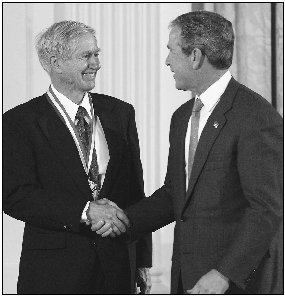Introduction
The Warming of the Earth
In 1958, a scientist named Dr. Charles David Keeling invented an unusual object that caught the attention of the scientific world. The instrument Keeling designed and built was called a manometer, and its purpose was to measure levels of atmospheric carbon dioxide (CO 2 ). Like all scientists, Keeling knew that CO 2 and other gases existed naturally in the earth's atmosphere. He suspected, though, that CO 2 levels were steadily growing higher. Since the Industrial Revolution, a period of rapid industrial growth in Europe and America during the eighteenth and nineteenth centuries, manufacturing had flourished. This caused more CO 2 than ever before to be pumped into the air. Keeling suspected that this might be lingering in the atmosphere, and some scientists agreed with him. However, until the invention of the manometer there was no way to measure CO 2 levels, so no one had previously been able to prove that levels were higher than normal.
Studies in Hawaii
To get the most objective readings from the manometer, Keeling set up a sampling station on Mauna Loa, a massive volcano two miles above the Pacific Ocean on the island of Hawaii. He believed that this pristine, isolated location would be perfect 9 for his experiment because his measurements would not be influenced by human activities or industrial pollution. After taking a series of readings, Keeling determined that carbon dioxide levels in the atmosphere were 315 parts per million (ppm).
At first, his discovery was not of particular significance because there were no past measurements to use for comparison. In the 1980s, however, Keeling's findings became very significant. Researchers studying ancient ice from Antarctica found that carbon dioxide levels had been about 280 ppm in the 1700s, before the Industrial Revolution had begun. When these measurements were compared with Keeling's findings, the researchers could see that CO 2 had steadily increased over a period of two hundred years. Also during the same period of time, scientists were taking thermometer readings of the earth's surface,

A Hot Topic
When Keeling first began measuring CO 2 on Mauna Loa, the term global warming was relatively unknown. With the exception of a few articles scattered throughout scientific publications, there was no publicity about global warming and most people were not aware of it. That is no longer the case, however. Today, global warming has become an environmental issue that makes news headlines nearly every day, and whose significance the National Aeronautic and Space Administration (NASA) describes as follows: "As an Internet search on global warming now attests, the subject has become as rooted in our public consciousness as Madonna or microwave cooking. Perhaps all this attention is deserved. With the possible exception of another world war, a giant asteroid, or an incurable plague, global warming may be the single largest threat to our planet." 1
In the past hundred years, the earth's surface temperature has risen about one degree Fahrenheit. This may not seem like a significant amount, but scientists want to know what is causing it. In addition, climate measurements show that the most rapid warming in history occurred during the 1990s, with 1998 registering as the hottest year on record. This means that, unlike the past when it took about a thousand years for the earth's temperature to rise by one degree, the current warming is happening at an accelerated rate. Environmental consultant and author Dr. John J. Berger explains why he and many other scientists are alarmed about this rapid rise in the earth's temperature:
Global temperatures have risen before and nature has adapted. . . . But previous warmings of the magnitude now projected have taken place over millennia, not over decades or centuries. The natural world has had far more time to adapt to the new conditions. 2
Some scientists insist that this warming trend is due to natural occurrences. Since the earth has existed, its climate has constantly changed, shifting from warm periods to cold periods and then back again. The scientists who are most doubtful about the risks of global warming insist that Earth is a robust planet that has survived fluctuations in temperature over millions of years, and will continue to do so. They believe the current global warming trend is yet another natural cycle that should be expected.
Other scientists, however, strongly disagree. While they acknowledge that the planet has gone through many climate changes in its history, they believe that the current global warming trend is different because it is being caused by humans, not nature.
As with any complex issue, it is impossible to say who is right and who is wrong. No one can predict with certainty whether global warming will continue in the future—and scientists on both sides of the issue are very willing to admit this. Global warming has been a subject of controversy for many years, and there is every reason to believe that the debate will not end anytime soon. If history is any indication, the controversy is likely to become even more heated in the years to come.
Comment about this article, ask questions, or add new information about this topic: